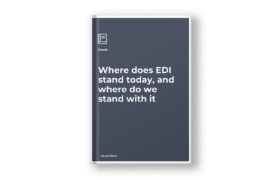At this point, it seems that businesses trying to stay relevant are not in a race against one another but in a race against time itself. That statement might seem like a stretch, but the truth is that it is quite easy to become irrelevant these days, exclusively considering the fact that technologies are evolving drastically, and simultaneously demanding change for the better. Exhibiting a sense of reluctance in adapting to change can be the beginning of irrelevance.
Your B2B network needs to be substantially optimized to facilitate critical business processes and maintain a robust relationship with your business partners. When we include the likelihood of maintaining and managing a sophisticated yet comprehensible B2B channel, at its foundation we have Electronic Data Interchange (EDI).
This eBook explores:
- What is EDI and how it came to be? Its evolution over the years and the acknowledgment of its foothold across essential service sectors.
- Why and how is EDI still relevant in this era of ever-changing technologies?
- A well-needed comparison between a manual B2B process and the same done through an EDI-enabled environment.
- EDI being a standard-specific process, it discusses some of the most commonly used and accepted standards such as: ANSI X12, UN/EDIFACT, RosettaNET, Tradacoms, and more.
- Necessary factors that need to be considered before deciding on an EDI communication protocol.
- The various communications protocols including: FTP (File Transfer Protocol) and VPN (Virtual Private Network), SFTP (Secure File Transfer Protocol) and FTPS (File Transfer Protocol Secure), and AS4 (Applicability Statement 4)
- Welcoming EDI for the better and the phases involved that guides you through the process of evolving from initial EDI stages towards having a more strategically enhanced EDI infrastructure.
- The two EDI implementation options: Direct EDI approach with in-house EDI implementation, or through Value-Added Networks (External Service Providers).
- The advantages of using a Value-Added Network (VAN) and how can it prove to be a better way to shift towards EDI.
- Symtrax offering in line with essential EDI requirements, along with the discussion of various success stories from clients that required an EDI solution for:
- Practical use-cases of EDI in day-to-day business scenarios particularly pertaining to the supply chain.
- The impact of EDI on the supply chain and some of its most critical business processes.
